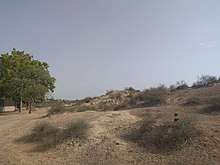Archaeology in India
Archaeology in India is mainly done under the supervision of Archaeological Survey of India.

History
The history of archaeology began in Western Europe, and the earliest scholars to take an interest in the archaeology of the Indian subcontinent were Western European travelers in the 16th, 17th and early 18th centuries. The earliest European written accounts of India's ancient monuments and Hindu temples were produced by sailors and travelers in the 16th, 17th and early 18th centuries CE. Some of these accounts included ground plans and drawings of the buildings, however they lacked any historical discussion of their origins, with the exception of several references to Alexander the Great, the Macedonian emperor who had conquered much of Northern India in the 4th century BCE.[1]
The history of Indian archaeology spans from the 19th century to the present, and includes a wide variety of archaeologists investigating the region's history. The history of archaeology began in Western Europe, and the earliest scholars to take an interest in the archaeology of the Indian subcontinent were Western European travelers in the 16th, 17th and early 18th centuries.
Some notable archaeological sites in India include Rahigarhi, an archaeological site located in the state of Harayana, India. Mohenjo-Daro[2] and Harappa are also ancient archaeological sites that were once a part of India, but now lie within the borders of Pakistan. The Harappan civilization was also called the Indus River Valley Civilization.[3]
Alexander Cunningham and the Archaeological Survey of India
Thomas R. Trautmann and Carla M. Sinopoli, 2002.[4]
Scholarly investigation into Indian archaeology was largely influenced by Alexander Cunningham, who became the first director of the Archaeological Survey of India, which was established in 1861. Cunningham along with various assistants visited many sites and monuments of archaeological importance in India. Their trips ranged from simply visiting sites to study and report on to excavations as well.[5]

Sites
Rahigarhi
In 1963, Archaeological Survey of India (ASI) began excavations at this site, and, though little has been published about the excavations.[6][7] Further excavations were conducted the ASI headed by the archaeologist, Amarendra Nath, between 1997 and 2000.[8][note 1] The more recent excavations have been performed by Vasant Shinde, an archaeologist from the Deccan College.[9]
Analysis and mapping of this site has shown it to be even larger than Mohenjo Daro.[9] Radiocarbon dating was used at this site to analyze soil samples. The results showed that the soil samples were dated back to the millennium of 2000 years BC.[10]
Notes
- Amarendra Nath was later found guilty for forging bills during the excavation at Rakhigarhi.
References
- Chakrabarti, Dilip K. (1982). "The Development of Archaeology in the Indian Subcontinent". World Archaeology. 13 (3). pp. 326–344.
- "Mohenjo-daro | archaeological site, Pakistan". Encyclopedia Britannica. Retrieved 2 August 2020.
- "Harappa | Pakistan". Encyclopedia Britannica. Retrieved 2 August 2020.
- Trautmann and Sinopoli 2002. p. 516.
- Ghosh, A. (9 May 1964). "Expedition Magazine - Penn Museum". www.penn.museum. Retrieved 12 July 2020.
- Wright, Rita P. (2009), The Ancient Indus: Urbanism, Economy, and Society, Cambridge University Press, p. 107, ISBN 978-0-521-57219-4 Quote: "Rakhigarhi will be discussed briefly in view of the limited published material" (p 107)
- Sinopoli, Carla M. (2015), "Ancient South Asian cities in their regions", in Norman Yoffee (ed.), The Cambridge World History, Cambridge University Press, p. 325, ISBN 978-0-521-19008-4 Quote: "Excavations have also occurred at Rakhigarhi, but only brief notes have been published, and little information is currently available on its form and organization. (page 325)"
- Nath, Amarendra (31 December 2014). "Excavations at Rakhigarhi [1997-98 to 1999-2000]" (PDF). Archaeological Survey of India. Archaeological Survey of India. p. 306. Archived from the original (PDF) on 19 March 2015. Retrieved 22 February 2016.
- Shinde, Vasant; Green, Adam; Parmar, Narender; Sable, P. D. (2012–2013). "Rakhigarhi and the Harappan Civilization: Recent Work and New Challenges". Bulletin of the Deccan College Research Institute. 72/73: 48. JSTOR 43610687.
- Vahia, Mayank N., Pankaj Kumar, Abhijeet Bhogale, D. C. Kothari, Sundeep Chopra, Vasant Shinde, Nilesh Jadhav, and Ranvir Shastri. "Radiocarbon Dating of Charcoal Samples from Rakhigarhi, Haryana, India Using Accelerator Mass Spectrometer." Current Science 111, no. 1 (2016): 27-28. Accessed August 2, 2020. www.jstor.org/stable/24910004.
Further reading
- D.P. Agrawal. The Archaeology of India. London : Curzon Press, 1981.
- Chakrabarti, Dilip K. (1982). "The Development of Archaeology in the Indian Subcontinent". World Archaeology. 13 (3). pp. 326–344.
- Chakrabarti D.K. 2009. India, an archaeological history : palaeolithic beginnings to early historic foundations
- Chakrabarti D.K. 2003. Archaeology in the Third World by Dilip Kumar Chakrabarti
- Chakrabarti D.K. 1988 A history of Indian archeology from the beginning to 1947
- Chakrabarti D.K. 2006. The Oxford companion to Indian archaeology : the archaeological foundations of ancient India, Stone Age to AD 13th century
- Braj Basi Lal (2011). Piecing Together - Memoirs of an Archaeologist. Aryan Books International. ISBN 978-81-7305-417-4.
- Aryas, Aryens et Iraniens en Asie Centrale Fussman, G.; Kellens, J.; Francfort, H.-P.; Tremblay, X.. (2005) Institut Civilisation Indienne ISBN 2-86803-072-6
- Dimensions in Indian History and Archaeology (S. P. Gupta and K. S. Ramachandran, eds.) New Delhi: Indian History and lture Society, 1993.
- Rao, S. R. (2008). Reminiscences of an archaeologist. New Delhi: Aryan Books International.
- New Trends in Indian Art and Archaeology: S.R. Rao's 70th Birthday Felicitation Volumes, edited by B.U. Nayak and N.C. Ghosh, 2 vols. (1992)
- Marine Archaeology in India, Delhi: Publications Division, ISBN 81-230-0785-X (2001)
- S.R. Rao, Marine Archaeology in India, Delhi: Publications Division, ISBN 81-230-0785-X (2001)
- Trautmann, Thomas R.; Sinopoli, Carla M. (2002). "In the Beginning was the Word: Excavating the Relations between History and Archaeology in South Asia". Journal of the Economic and Social History of the Orient. 45 (4). pp. 492–523.